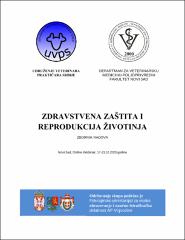Hemijski sastav etarskih ulja i jedinjenja sa antihelmintčkim potencijalom

View/
Date
2020-10Author
Štrbac, Filip
Stojanović, Dragica
Ratajac, Radomir
Metadata
Show full item recordAbstract
The irrational use of commercial anthelmintics has led to the development of anthelmintic resistance in many species of domestic animals endoparasites. Therefore, potential alternatives, such as the essential oils of various plants, are being intensively explored. Essential oils are secondary metabolites of plants with a very complex chemical composition that usually includes a large number of compounds of different chemical groups. These are usually various terpene, terpenoid or phenylpropanoid compounds, many of which have been identified, whereby it is important to note that the chemical composition of essential oils can vary depending on many endogenous and exogenous factors. There are numerous documented medicinal attributes of essential oils, including antimicrobial, anti-inflammatory and antioxidant effects, which is why these herbal products have found their application in the treatment of many diseases. In various in vitro and in vivo examinations, essential oils have been shown to have anthelmintic potential, which originates from various compounds that are part of their chemical composition. Among these ingredients, carvacrol, thymol, anethole, cinnamaldehyde, limonene, pinene, terpinene, caryophyllene, cymene, linalool, gernaiol, menthol, borneol, citral, camphor, eucalyptol, eugenol and many others stand out. Their isolated anthelmintic potential has also been confirmed in many studies, and their various synergistic combinations have been investigated. In addition to an increase in efficiency, the presence of a large number of compounds with different mechanisms of action can contribute also to less possibility of the development of resistant helminth strains. Also, the natural origin of essential oils can contribute to their less toxicity to animals compared to synthetic preparations. Therefore, it can be concluded that essential oils and their ingredients represent a promising alternative in combating anthelmintic resistance.
